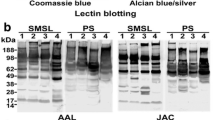Abstract
Electrophoresis of concentrated parotid saliva on slab polyacrylamide gels negatively stained with 3,3′-dimethoxybenzidine and hydrogen peroxide (DMB stain) showed nine phenotypes among the proline-rich proteins. These phenotypes are the expression of four autosomal codominant alleles. Gene frequencies are, for Caucasians, Pr 1=0.640, Pr 1′=0.005, Pr 2=0.080, Pr 2′=0.275; for Negroes, Pr 1=0.700, Pr 1′=0.050, Pr 2=0.080, Pr 2′=0.170; for Chinese, Pr 1=0.770, Pr 1′=0, Pr 2=0, Pr 2′=0.230. The presence or absence of another pair of proteins giving the same negative staining is inherited as an autosomal dominant trait (Db). Homozygous Db + + and heterozygous Db + − individuals could not be distinguished. The genetic determinant (Db) for this pair of proteins is either closely linked to or part of the Pr locus. Gene frequencies are, for Caucasians, Db +=0.12, Db −=0.88; for Negroes, Db +=0.56, Db −=0.44; for Chinese, Db +=0.07, Db −=0.93.
Similar content being viewed by others
References
Azen, E. A. (1972). Genetic polymorphism of basic proteins from parotid saliva. Science 176673.
Azen, E. A. (1973). Properties of salivary basic proteins showing polymorphism. Biochem. Genet. 969.
Azen, E. A., and Oppenheim, F. G. (1973). Genetic polymorphism of proline-rich human salivary proteins. Science 1801067.
Balakrishnan, C. R., and Ashton, G. C. (1974). Polymorphisms of human salivary proteins. Am. J. Hum. Genet. 26145.
Hay, D. I. (1969). Some observations on human saliva proteins and their role in the formation of the acquired enamel pellicle. J. Dent. Res. 48806.
Merritt, A. D., Rivas, M. L., Bixler, D., and Newell, R. (1973a). Salivary and pancreatic amylase: Electrophoretic characterization and genetic studies. Am. J. Hum. Genet. 25510.
Merritt, A. D., Lovrein, E. W., Rivas, M. L., and Conneally, P. M. (1973b). Human amylase loci: Genetic linkage with the Duffy blood group locus and assignment to linkage group I. Am. J. Hum. Genet. 25523.
Morton, N. E. (1955). Sequential tests for the detection of linkage. Am. J. Hum. Genet. 7277.
Oppenheim, F. G., Hay, D. I., and Franzblau, C. (1971). Proline-rich proteins from human parotid saliva. I. Isolation and partial characterization. Biochemistry 104233.
Smith, C. A. B. (1959). Some comments on the statistical methods used in linkage investigations. Am. J. Hum. Genet. 11289.
Smithies, O., Connell, G. E., and Dixon, G. H. (1962). Inheritance of haptoglobin subtypes. Am. J. Hum. Genet. 1414.
Author information
Authors and Affiliations
Additional information
This study was supported by a grant from the National Institutes of Dental Research (9-R01-DE-03685-08) and in part by grant GM 15422 from the National Institutes of Health.
Rights and permissions
About this article
Cite this article
Azen, E.A., Denniston, C.L. Genetic polymorphism of human salivary proline-rich proteins: Further genetic analysis. Biochem Genet 12, 109–120 (1974). https://doi.org/10.1007/BF00487820
Received:
Revised:
Issue Date:
DOI: https://doi.org/10.1007/BF00487820




